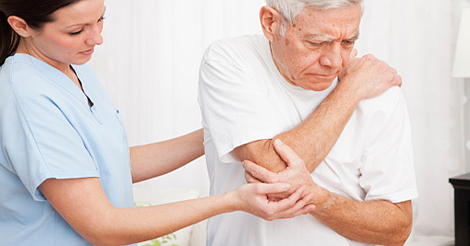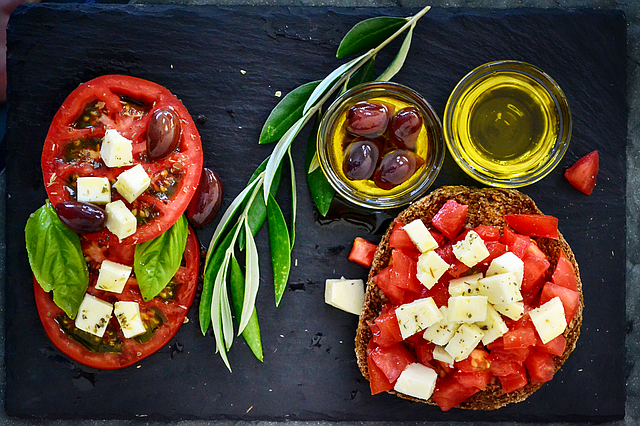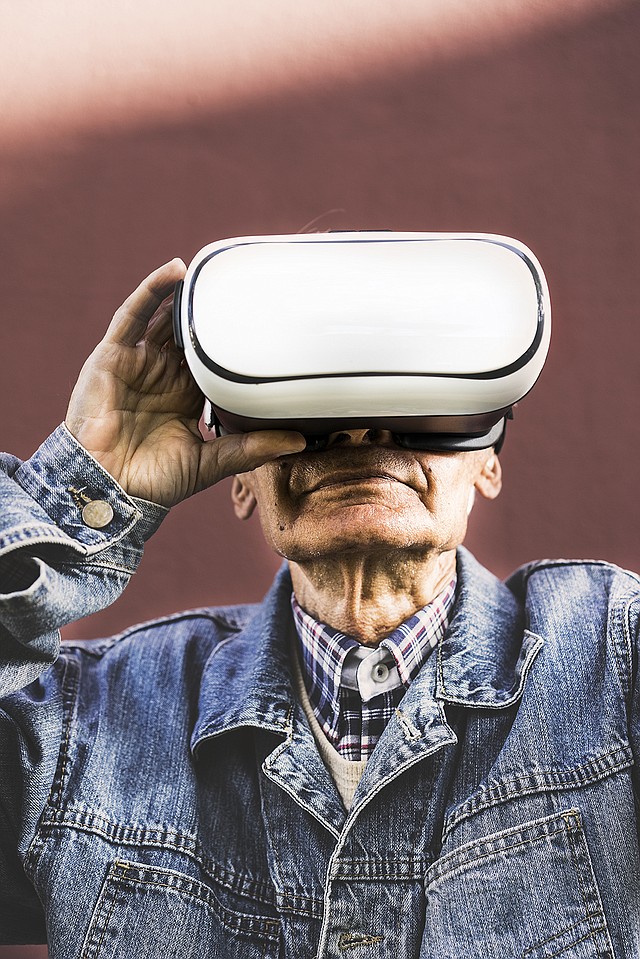Pain management options
April 11, 2020 at 3:15 p.m.
By Maddie Smith
Treating chronic pain is essential in maintaining mobility, strength and a positive attitude, whether a patient is recovering from a surgery or cancer treatment, or coping with aging in general. It is very common for doctors to prescribe opioids to patients for their chronic pain, even if the patient is not aware of other options.
Joan Maxwell is a patient advocate for alternative treatments for chronic pain. After she was diagnosed with breast cancer, she needed nine surgeries including a double mastectomy. She said she did not have a conversation with her doctor about pain management options for any of her surgeries.
“Nine times I had surgery and nine times I was prescribed opioids,” Maxwell said.
About 11% of adults in the U.S. live with chronic pain and about 17% live with severe levels of pain, according to a National Health Interview Survey conducted in 2012. There is a plethora of information circulating about pain management treatments and even more treatments that don’t get attention from the medical community. Each patient is different, as is each treatment. Public Broadcasting Service hosted an informative panel discussion in December 2016. Here is what some of the experts in the field have to say about managing pain.
Dr. Christopher Valley- specialist in chronic pain and fibromyalgia at Arthritis Northwest
“Collaboration is key,” said Dr. Valley.
Educating patients and prescribing exercise regimens are his specialty, but he likes to reach out to other experts for advice on other types of treatments, he said.
Dr. Valley works with many patients who have fibromyalgia, which is a difficult condition to diagnose. In order to deliver an accurate diagnosis, he pays close attention to information the patient is telling him. He looks at the patient history but does not take previous diagnosis made by other doctors at face value. Lastly, he performs a thorough physical exam on the patient.
A good physical exam is time consuming, according to Dr. Valley. Most primary care physicians do not have enough time to conduct a thorough physical exam, he said.
Education about pain is important for patients, especially in relation to exercise. Making the patient aware that their pain is temporary and manageable is crucial in their recovery. He prescribes exercise just as a physician would prescribe a medication, writing it down on a prescription and starting with small doses. Dr. Valley takes into account the limits and boundaries of his patients and adjusts dosage of exercise accordingly. He also makes them schedule a time to do their exercise and write it down in a planner.
“I think human beings are a little better with appointments than we are with abstract concepts,” he said.
A low-inflammation diet has also shown signs of helping with pain management in some cases, although research is still underdeveloped, said Dr. Valley. Low-inflammation diets include vegetables and healthy fats and cut out many processed foods and refined sugars. For more information on using diet for pain management read the “What should you eat to help with chronic pain” sidebar at the end of this article.
Cheyenne Newsome- Assistant clinical professor of pharmacotherapy at WSU
Newsome was the panelist with the most knowledge on opioids. She acknowledged the severity of the opioid epidemic on the country, specifically on Washington state and Spokane, where the panel discussion took place. As opioids are being prescribed more and more, the risk of overdose goes up. Newsome said that the goal for prescribing opioids is to prescribe the smallest dosage for the shortest amount of time possible. Patients should keep in mind that opioids are not a cure for pain, rather a way to manage pain, she said.
In the horrific case of opioid overdose, there is a reversal agent available in pharmacies, Newsome said. The drug is called Naloxone and it can be prescribed by a doctor to addicts or loved ones. Select pharmacies can even prescribe the drug without a doctor’s prescription. Naloxone can save lives during an opioid overdose by blocking the opioid receptors in the brain.
Newsome’s job is to evaluate the severity of the patient’s pain and use all the resources available to manage their symptoms. As far as medications go, over-the-counter drugs like ibuprofen can be helpful in managing pain before jumping straight to opioids. There are also opioid patches available which deliver consistent levels of the drug rather than the fast-releasing oral pills. Patches are good for people who have trouble sticking to a schedule that oral pills require.
There are also a wide variety of patches and creams that don’t require a prescription. From heat patches to creams made from peppers that block nerve receptors, methods for pain management are plentiful at pharmacies. Newsome urges patients to consult with a health care provider before trying any new treatments though, as some of them do not react well with each other. For instance, patients should avoid putting a heat patch in the same place where they recently applied an opioid topical patch.
Sonya Wood- Clinical psychologist at St. Luke’s Rehabilitation Institute’s pain and psychology department
Wood offered a unique psychological perspective on pain.
“Pain doesn’t seem to stay in a bubble,” she said.
Wood’s work focuses on the relationship between physical pain and the patient's mentality. She takes a holistic approach to pain management by asking patients how they are feeling both physically and mentally. From here, Wood and her colleagues can determine the overall effects of a patient’s pain and how to minimize them.
Wood calls this the cognitive behavioral approach. She evaluates all aspects of the patient’s life-- relationships, school, work, ect.-- to see if they are helping or hurting their pain levels.
The patient’s attitude plays a huge role in their recovery. The way a patient thinks will determine how they feel and how they behave, Wood said. Oftentimes, patients experience fear after having a surgery or an accident. This fear can prevent them from doing things to advance their recovery like exercise and physical therapy. Furthermore, added stress in a patient's life can make their pain worse.
“Our body can be in a constant fight or flight state,” Wood said.
This ‘fight or flight state’ can even affect a patient’s sleep schedule. Wood thinks that if health care providers take the time to listen to their patients and address their fear and stress it would help in their recovery.
Lack of a diagnosis is a very challenging aspect of living with chronic pain. Many chronic pain conditions mimic each other, like fibromyalgia. Patients often become frustrated by the lack of answers. Wood said that treating symptoms is a good way to manage frustration. Treatments like physical therapy, exercise and diet are all ways to manage pain, even if the patient does not have a diagnosis yet.
“All of these little things add up,” Wood said.
Dr. David Burns- Anesthesiologist and Interventionist- Providence Anesthesia Services -- specializes in acute pain
As an anesthesiologist, Dr. Burns offered insight about acute pain to the panel. Surgery-related pain often translates to long-term pain post-op. If the acute pain due to surgery is treated at the time of surgery, there is a lower chance of a patient experiencing chronic pain down the road, according to Dr. Burns.
Providence Anesthesia Services uses a ‘multi-modal’ approach to pain treatment. First, doctors deliver nerve blockers to prevent patients from experiencing the most acute pain of their surgery. Nerve blockers can last from several hours to days post-op. The patient’s lack of feeling for the worse part of the pain helps them in their recovery because they are more willing to participate in physical therapy. For instance, a patient who received nerve blockers during their knee replacement surgery won’t be as timid in physical therapy as a patient who experienced the acute pain from surgery. This will help their chances in healing and gaining back their mobility.
Dr. Burns brought up a preliminary operation for joint pain relief. Early studies are testing stem cell and cartilage injection as an alternative for knee and hip replacements. Over time, the cartilage in joints wears thin, removing the protective layer between bones and causing chronic pain from the bones scraping together. This is why people get knee or hip replacements. Emerging stem cell and cartilage injection studies hope to eliminate the need for joint replacement surgeries.
Dr. Burns also mentioned the importance of maintaining a healthy sleep schedule. He said that health care providers could help with this on the inpatient side of the hospital. Instead of the night staff checking on a patient every hour during the night, ‘clustering care’ could be helpful. This means that, instead of checking on a patient every hour, to check vitals and things of the sort right before bed, to minimize check ins in the middle of the night so that the patient can get more sleep.
Dr. Burns cautioned viewers about opioids. He thinks that healthcare professionals have done more damage than good in prescribing opioids.
“Opioids can be a two-edged sword,” said Dr. Burns.
Dr. Ryan Barnes- Physicist at Rockwood Physiatry Center -- specializes in musculoskeletal pain disorders
Dr. Barnes specializes in physical therapy. He talked a little bit about the process of evaluating the best treatments for patients with chronic pain. Each patient is different, and physical therapy is not the right choice in all cases.
Physical therapy is a long process, especially for patients living with chronic pain. It is important for physicists to give their patients detailed information on what their goals should be for therapy and how to attain those goals. Many patients also struggle with consistency during their therapy treatment, so it’s important for healthcare providers to encourage their patients to stick with treatments.
His views are similar to Dr. Valley's value of exercise and education as effective treatments. Dr. Barnes thinks that exercise is the best treatment for chronic pain but it is also the hardest treatment to keep up with. Doctors should do their best to educate patients on the pros and cons of exercise, and should make sure that patients aren’t overexerting themselves.
Chronic pain is an extremely common condition. Approximately 84% of people experience back pain in their lifetimes, according to Dr. Barnes.
For patients who struggle with keeping a healthy sleep schedule, there are many sleep books available. Dr. Barnes suggested that healthcare providers practice sleep restriction to keep patients on a normal sleeping schedule. Sleep restriction is similar to the cluster care method that Dr. Burns mentioned. Doctors and nurses should encourage the patient to stay awake during the day by keeping the blinds open and providing treatments and care when the sun is out. By keeping a patient awake during the day, they are more likely to sleep regularly at night.
The panel took an inside look on Connie Pace’s life with chronic pain. Since her hip replacement surgery, Pace has experienced chronic pain.
“I miss a lot of things I would like to do, especially with my grandchildren,” Pace said.
Through her pain, Pace remains optimistic. She continues to move around and do her treatments with the help of her husband. Her pain management treatments include an opioid patch, massage, chiropractic and physical therapy in the water.
The National Center for Complementary and Integrative Health created a resource for treatments for chronic pain. Visit https://files.nccih.nih.gov/s3fs-public/Pain-eBook-2019_06_508.pdf . Or email editor@northwestprimetime.com to have resources mailed to you.
What should you eat to help with chronic pain?
Anecdotal information abounds on alternative pain treatments, including following an anti-inflammatory diet. A Seattle-area senior who lives with osteoarthritis says her pain levels improved when she cut sugar and processed foods from her generally healthy diet, but the pain disappeared completely when she added a daily turmeric supplement.
The Arthritis Foundation cites the Mediterranean diet for alleviating inflammation and joint pain. The Mediterranean diet avoids processed foods and is heavy in fish, nuts, beans, fruits and vegetables. The diet can alleviate pain by reducing inflammation, protecting joints and heart health, helping in weight loss and lowering blood pressure. Here’s the breakdown of ingredients to incorporate into your diet to make it more Mediterranean :
Fish: Fish are high in omega-3 fatty acids, which help to reduce joint swelling and pain. Here are the best fish to eat to relieve pain:
Salmon
Tuna
Herring
Anchovies
Scallops
Other cold water fish
Alternatively, you can take fish oil supplements.
Nuts and seeds: Nuts are high in vitamin B6 and monounsaturated fat, both of which fight inflammation. Monounsaturated fats are high in calories and fat, but they actually aid in weight loss because they contain protein and fiber which curb hunger. These nuts are packed full of monounsaturated fats and vitamin B6:
Walnuts
Pine nuts
Pistachios
Almonds
Fruits and vegetables: Antioxidants in fruits and veggies bulk up your body’s defense system by protecting cells. Red and purple fruits like cherries, strawberries and raspberries have anti-inflammatory effects, according to research. Citrus fruits are rich in vitamin C, which maintains healthy joints and prevents inflammatory-related arthritis. Green vegetables like kale, cabbage, lettuce, spinach and broccoli are rich in vitamin K, which are also anti-inflammatory. At least nine servings are recommended daily for the Mediterranean diet (a serving is equal to one cup of fruit or two cups of leafy greens). Here are some fruit and veggie recommendations:
Blueberries
Cherries
Broccoli
Spinach
Kale
In general, fruits and veggies with darker or brighter colors are higher in antioxidants.
Olive Oil: Olive oil contains fats that maintain heart health and a compound that reduces pain sensitivity and inflammation. The Mediterranean diet recommends eating two to three tablespoons of olive oil daily.
Beans: Beans are a great source of fiber and anti-inflammatory nutrients. They have the added bonus of being cheap and loaded with protein (around 15 grams per cup). The recommended amount of beans to consume is at least two cups per week. Here are the best types of beans for the Mediterranean diet:
Small red beans
Red kidney beans
Pinto beans
This list is not exclusive. There are other foods that are anti-inflammatory and can help alleviate pain. For more information on the Mediterranean diet visit https://arthritis.org/health-wellness/healthy-living/nutrition/anti-inflammatory/the-ultimate-arthritis-diet or call 404-872-7100
Cannabis as a treatment for chronic pain:
People who experience chronic pain are drawn to cannabis as a pain management treatment because it is easy to obtain in Washington and they can control how they use it, said Lisa Buchanan. Buchanan is a nurse and licenced medical marijuana consultant at Dockside Cannabis, a Seattle-based medicinal cannabis dispensary.
Scientific research on the use of medical marijuana for pain treatment is still underdeveloped due to the chemical complexity of cannabis and the prohibition of the drug in most states. Dr. David Bearman discussed medical marijuana with Practical Pain Management to help patients get a better understanding of cannabis. The THC compound found in cannabis stimulates the brain’s cannabinoid receptors, which are responsible for pain reduction and a dazey “high” feeling. CBD is the other compound in cannabis which communicates with pain receptors in the brain to relieve pain and inflammation. Dr. Bearman recommended a one-to-one ratio of THC and CBD for patients with concerns about feeling “high” after consuming cannabis. Every patient is different, but he generally recommends 15mg of each compound about three times per day for pain reduction.
Buchanan said many older adults choose the one-to-one THC/CBD ratio because “It feels good and doesn’t feel overly psychoactive.” ‘
Christine Cohen, marketing director for Hashtag Cannabis, agrees with the one-to-one ratio for older customers because there are several scientific studies that show the ratio provides the greatest health benefits.
However, once a patient becomes comfortable using cannabis as a pain treatment, they are more likely to adjust dosage to a comfortable level.
“In the medicine world, we’d call that ‘as needed,’” said Buchanan.
Studies found that THC increases the bioavailability of CBD, which enhances the effects of the drug, according to Buchanan.
Most seniors walk out of Dockside Cannabis with a topical cream because they have localized pain like arthritis and they want to have control over the psychoactive effects of cannabis. Cohen said that the same is true for Hashtag Cannabis, although many experiment with edible cannabis products once they are comfortable doing so.
Both Buchanan and Cohen said they’ve witnessed older customers have tremendous success using medicinal cannabis products to treat pain.
“Even our owner’s mother finds topicals to be really effective on some of her arthritic joints,” said Cohen.
For more information visit: Medical News Today or call Practical Pain Management at 973-783-7009
*Dockside Cannabis and Hashtag Cannabis & Supply Co. are advertisers for Northwest Prime Time. For more information or to take a cannabis class at one of their Seattle-area stores visit https://www.docksidecannabis.com/ and https://www.seattlehashtag.com/ or call 1-844-362-5420 and (206)946-8157.
Virtual reality goggles as a pain treatment:
University of Washington’s School of Medicine is conducting research on the potential role of virtual reality games for pain management. Dr. Reza Firoozabadi is an orthopedic trauma surgeon who is conducting the research. He reported a virtual reality game offering a patient a distraction while Dr. Firoozabadi performed the painful procedure of removing stabilizing pins from the patient. For more information visit https://orthop.washington.edu/dr-reza-firoozabadi-featured-in-national-geographic-magazine-for-use-of-virtual-reality-in-pain or call UW School of Medicine at 206-543-3690.
Of course, there are many ways individuals can improve their pain level without the help from outside treatments. Physiotherapist and pain specialist Nicky Snazell shares healthy lifestyle methods to reduce pain levels.
Is Your Aging Body Sending Distress Signals?
Save It From A Diabolical Enemy – You
If we neglect our bodies, misuse them, or otherwise fail to treat them with proper respect, they have an effective means of expressing their dissatisfaction.
We feel pain – in our joints, in our muscles, in our backs; pretty much any place where there exists a nerve that can fire off an urgent distress signal to the brain.
And as we age, those distress signals seem to become more frequent, with the simplest of movements, such as bending over to pick up a fallen object, creating anguish and instant regret.
“Unfortunately, pain and aging are facts of life,” says Nicky Snazell (www.painreliefclinic.co.uk), a physiotherapist, expert in pain management, and author of The 4 Keys to Health and other books.
“The good news is that, ultimately, our quality of life doesn’t have to be ruled by age and pain themselves, no matter what we might think. Instead, our quality of life is determined by how we handle age and pain.”
In many ways, we’re our bodies’ own worst enemies. But Snazell says those who want to treat their bodies the right way can accomplish that by making changes in four key areas:
Mindset. Your mindset affects all aspects of your health, Snazell says. “Without a positive, long-term commitment to health, you will not eat and drink well, you will not get regular and adequate exercise and you will not be able to control your stress,” she says. “Without first getting your head in the right place, how can you expect to make all of these changes to your life?”
Nutrition and hydration. It’s no secret that most of us don’t have the best diets, Snazell says. “We eat too much of the food that enhances pain,” she says, “and too little that reduces pain.” Our ancient ancestors had the right idea, she says. They ate fresh meat, berries, roots and fruit and vegetables high in antioxidants, and they had no processed foods. Perhaps more surprising, Snazell says, is that many people also aren’t properly hydrated. “Water is necessary for mental agility, the immune system, healing, cleansing and detoxing,” she says, “so it is definitely not something we should ignore.”
Fitness. Televisions, computers and smartphones helped turn us into a sedentary society self-imprisoned on our sofas. “The lack of physical activity causes emotional and physiological imbalances,” Snazell says. “Improving your fitness changes your chemistry, acts as a powerful antidepressant, promotes mental clarity, and reduces the likelihood of cancer.” Being disciplined about getting exercise is your key to longevity, she says, so exercise regularly and effectively. Running, for example, helps you lose dangerous belly fat that causes inflammation and aids stress. If running proves difficult or isn’t your thing, there are plenty of other aerobic exercises, such as golf, walking, swimming, rowing and cross country skiing, among others.
Lifestyle. “If you want to start changing your lifestyle right now to improve your mental and physical health, there are several small, simple things you can do to get headed in the right direction,” Snazell says. Here are just some of them: Get a regular massage, meditate daily, set purposeful goals, do something nice for a stranger, watch less TV, study something every day, spend time with inspiring and funny people, sing in the shower.
“As we age, we need to put even more care into our diet, our exercise and our workload,” Snazell says. “It sounds simple but many of us fail to even acknowledge that we have to change the way we use our bodies as we get older.
“We need to remember that so much of this is a choice. We have the power to change ourselves by transforming the way we think, what we eat, how we move and what kind of lifestyle we choose to lead.”
About Nicky Snazell
Nicky Snazell (www.painreliefclinic.co.uk), author of The 4 Keys to Health and other books, is director of Nicky Snazell’s Wellness & Physiotherapy in the United Kingdom. She is a physiotherapist and pain specialist. Snazell is the founder of three health companies and still treats patients, embracing holistic physiotherapy, healthy living, and new technology for joint repair. After 30 years of treating patients, including about 14,000 at her clinic’s Midlands location, Snazell has seen a huge success rate. She also makes presentations internationally on health, wellbeing and pain relief.








